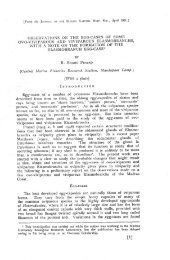PDF - Eprints@CMFRI
PDF - Eprints@CMFRI
PDF - Eprints@CMFRI
Create successful ePaper yourself
Turn your PDF publications into a flip-book with our unique Google optimized e-Paper software.
\22<br />
seyebellensis, which was later followed by PILLA I, VINE & SCHEER (1973). WljSMAN-BEST (1972)<br />
opined that Prionastrea seyebelle11sis MILNE EDWARDS & HAIME is a Favites , according to MATTHAI<br />
(J 914) it is near to Favia favus. CHEV ALI ER (1971) merged GOl1iastrea australensis with G. peetinata, but<br />
VERON et al. (1977 ) kept them separate. The only major distinction between these two are in the form<br />
of the corallites, that is, in G. pectinata majority of the calices is monocentric . However , it may be noted<br />
that many specimens of G. plal1ulata (= peetinata) have meandering valleys, though shorter than in G.<br />
australensis.<br />
More about G. sey ebellensis ee unter the following "Additional remarks".<br />
Additional rem ark s to the genus Goniast'rea :<br />
Prionastraea sey cbellensis MILNE EDWARDS & HAIME, 1849 , 132 .<br />
MILNE EDWARDS and HAIME'S type of Prionastraea seycbelle1/Sis is, according to CHEVA LI ER<br />
(1971: 189) a badly preserved specimen . Therefore the opinion of different authors about the taxonomic<br />
position of this species is very heterogeneous.<br />
KLUNZ INGER (1879) named it Goniastraea seycbellensis; his fig. 3, pI. 4, has much resemblance to<br />
fig. 6 (above), pI. 6, of CROSSLAND (1948), which we put to Goniastrea australensis. FAURE & PICHO<br />
(1978) have examined the type of CROSSLAND'S figured specimen and consider it as different ftom<br />
MILNE EDWARDS and HA IME'S type.<br />
ORTMANN has mentioned G011iastraea seycbellensis three times (1888, 1889 and 1892) from Red Sea.<br />
In 1888 he gave this name to a Goniastraea balieora in the Srrassbourg Museum , one of KLUNZINGER 's<br />
duplicates, which were acquired by several museums . We have in HLM such a duplicate, toO , EC 7 l , which<br />
we list under Favites balicora.<br />
MATTHAI (1914 : 122) had no doubt that Prionastraea seycbellensis and EHRENBERG's Astraea<br />
deformis belong together, and he referred them with a query to Favia favus (I9 l4: 80). CHEVALIER<br />
\ 1971) supposed Prionastraea seycbellensis is related to Favites abdita, and afterwards WljSMAN-BEST<br />
( 1972) and VERON , PICHON & WljSMAN-BEST (1977) put it definitely to Favit es abdita.<br />
Two specimens of Prionastraea seycbellensis in BMNH were placed to Favites peresi by FAURE &<br />
PICHON (1978). These authors have located in the Paris Museum another specimen of this name with a<br />
number of BMNH and labelled as holotype from the Seychelles, which they put to Favia favus.<br />
Because of this diversity of opinions it is not possible to give a generally valid synonymy of Prionastraea,<br />
or Goniastrea resp ., seycbe//ensis. Due to this uncertainty it may be the best to suppress the<br />
specific name seyebellensis in connection with any faviid coral.<br />
Goniastrea bombroni (RouSSEAU ), 1854, 122; pI. 28/3, 3a.<br />
SCHEER ( l967, 432, figs. ll , l2) has reported Goniastrea bombroni from the Red Sea (X2 : 9- 19).<br />
He referred to Favia bombroni by GARDINER (1904, 771; pI. 62/27 ) and MATTHA I (1914, 107 ; pis.<br />
2611 , 2; 33 12). Later on SCHEER & PI LLAI (1974 , 51; pI. 2411 - 4) added G. bombroni from the Nicobar<br />
Islands. Bur all these forms do not belong to bombroni se nsu ROUSSEAU . HisParastraea bombronii (1854)<br />
is identical with Favia ste//igera, stated by ROSEN (1971,80) who refers to WELLS, and by CHEVALIER<br />
(1971 , 162 and 168), and confirmed from WIjSMAN-BEST (1977 , 20). P. bombronii and F. stelligera<br />
have rounded calices separated from each other, whereas the above mentioned forms are cerioid with<br />
polygonal calices, whose septa continue from one calyx to the other. We put these forms for the present<br />
to Goniastrea retiformis, and therefore we have listed X2 : 9- 19 under " Material" of this species.<br />
Genus Platygyra EHRENBERG, l834<br />
Ty pes p e c i e s: Madrepora (Platygyra) lamellina EHRENBERG, 1834, = Madrepora daedalea ELLIS<br />
& SOLANDER , 1786 .<br />
Generi c characters: Massive, meandroid, valleys enclosed between thin, perforated , acute<br />
collines. Width of valleys 5 to 7 mm , depth about so much. Monocentric corall ites so metimes present.<br />
Septa slightly exsert, continuous over the wall ; edges dentate. Columella trabecular, continuous .
















